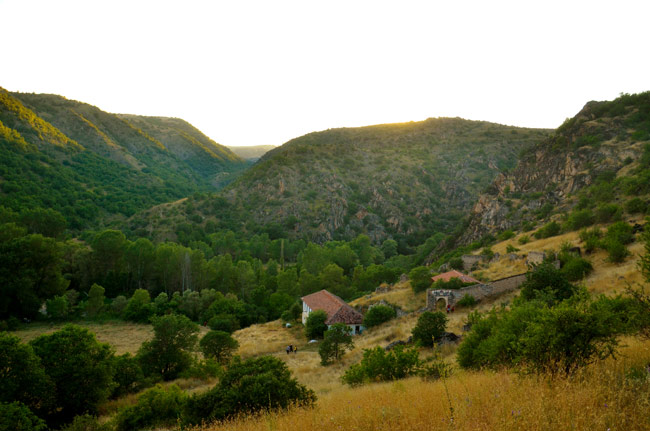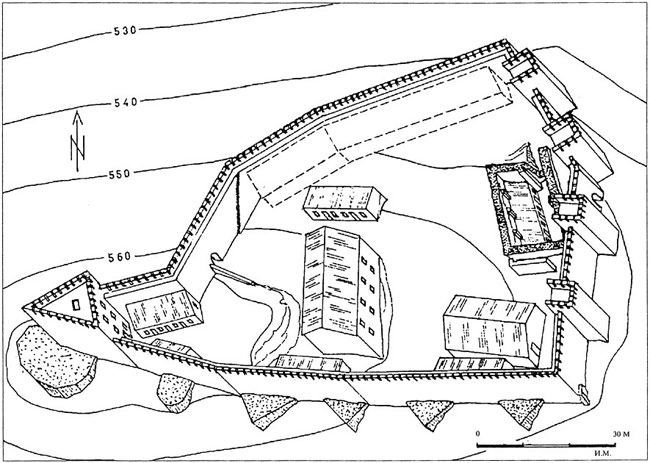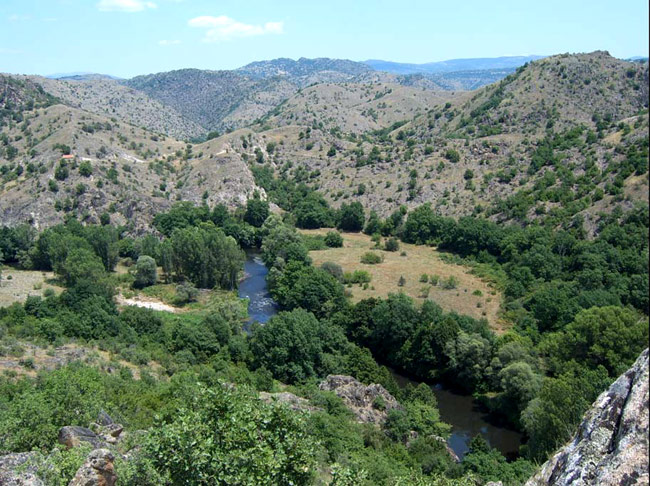Chebren – Monastery Complex

Chebren is a place in Mariovo with rich history. Chebren area belongs to the village of Zovikj, i.e. municipality of Novaci.
According to the written historical sources, the town on locality “Chebren” nearby the village of Zovikj, in the middle ages was known as ”Chemren”. Serbian archbishop Danilo confirms this during the reign emperor Dushan in his book “Lives of Serbian Kings and Archbishops”. Besides other towns he mentions the town of Chebren. Today this could be seen from the saved remains of stones.
The town of Chemren, according to the historical data, until 1331-34, when it was conquered by Emperor Dusan, was part of the Byzantine Empire. By the arrival of the Ottomans the town ceased to exist and in its place a small village remained with the monastery "St.. Demetrius "known today as" Chebren ".
The small village slowly disappeared, leaving behind only the monastery that in the early 18th century had a school for priests who performed service in the churches throughout the area Mariovo. The monastery was highly developed until the first decades of the twentieth century.

Sketch of reconstruction of the medieval town of Chemren with rampart reinforced with several towers
The site "the town of Chebren" lies on a separate volcanic pile or mound in the Canyon of Crna Reka (Erigon in ancient times), and in the low area along the river south of the mound around 140 meters high above the river, and not far northwest of the village Zovikj.
In this area you can still see the ancient and medieval remains of a monastery and the displaced village of Chebren. Local mountain road which started from the field to the west and cut the south Mariovo plateau touched Chebren and climbed to the bosom of Kajmakchalan - Kozhuf on east towards the old iron mines. Today it is the road section Suvodol - Rapesh - Manastir - Polchishte. Archaeological researches led by experts from the then National Museum of Bitola in the mound Chebren proved the existence of the ancient settlements from the early reign of the Macedonian kings, according to the discovered coins from that period.
View of the Chebren area
View of the medieval complex with visible remains of the rampart and other facilities
In this area, beside the remains of the acropolis, cistern, basilica, a building has been discovered that according to the opinions of archaeologists, is probably within the early Christian church. It is an object carved in rock, in the middle of it smaller facility in the form of a cross has been carved, and four circular holes in the corners of the rectangular platform. This facility was a so-called martyrium which kept the relics of a Christian martyr from the first centuries of Christianity, when Christians were persecuted by the Roman rule. Close to this building there is large granite slab with engraved relief – four –leaved clover and many smaller four –leaved clovers, which probably belongs to the above mentioned building. Similar form of carved cross has been found on a stone block in the three-nave church in the village of Manastir. Our comment is that maybe this construction with carved cross within the Late Antiquity - Early Christian basilica can be kind of a small baptistery for baptizing new Christians. Clover as a symbolic motif occurs in the early Christian period as an expression of the divine trinity.
The archaeological research in recent years in this area (along the river), proved that in late antiquity castrum was built with large dimensions, while lower, southward, civilian settlement began to develop within the same defensive wall (surrounding wall). This whole space was limited - fortified around and reinforced by numerous towers. According to the identified remains we get an idea of planned urban establishment covering 5 ha. In the center of the settlement a temple of basilica type was built dated V-VI century; its foundations and parts of marble sculpture are seen in and around the medieval church. Pieces of marble probably are pillars of marble iconostasis partition, but there are remains of columns, capitals and bases made of stone which probably originated from the nave of the basilica. There is evidence that the settlement of the locality "Chebren" existed in the period before the Roman occupation, i.e. during the rule of the Macedonian Empire. Coins from the kings of ancient Macedonia found prove this. Coins of the Macedonian king Philip II (359-336 BC), Cassander (316-297), followed by an autonomous Macedonia, Antigonus Gonatas (277-240 / 39 BC), Philip V (221-179 BC), Perseus (179-168 BC), coins cities Amphipolis and Thessalonica, and the Arcadia originate from the site.
The period, when the basilica was built and V-VI century, defined as early Byzantine is considered as relatively peaceful without any major shocking events. But, Byzantine emperors Leon and Zeno, then Anastasius and Justinian I experiencing earlier devastation from the Goths, then the Huns, considered this as a future serious problem, therefore they focused on architectural activity that would ensure protection of existing refuges, sentries, mining settlements, towns, villages, through construction or reconstruction of planned fortification systems. Thus, in this period military imperial architects were engaged in restoring or constructing many new fortresses and cities. Same happened with the town of Chebren, whereby it was fortified. Today there are remains of the fortification wall of the period.
Traces of the old mines and iron slag can be found at several places on the site. The main economic activity in Late Antiquity in Macedonia was mining. The state took care of the safety of mines and smelter, so for this purpose numerous small fortresses were built, where officials, controllers, specialists and guards stayed.

Graphic representation of the cross reliquary
Metals were melted here under state control, metal products were kept here until the final delivery to the state. If there was potential danger, the workers and miners from that area were harboring in these fortresses fortified with walls. Until XII-XIII old defensive fortresses were used’ if they were destroyed or partially destroyed they were renewed or adapted. Same happened with the defensive wall of the town of Chebren, whereby the rampart was restored, the towers and the acropolis from XIII century. New surrounding wall deviates from the Late Antique wall. Then the church was also renovated. The medieval church was built over the basilica from XIII - XIV century, but with smaller dimensions. For the same, there are data that it was again restored and painted in the XVI century. At the time, another church, dedicated to St.Elijah (Ilija), was built in the southeast corner of the ancient surrounding wall.
During the period of Ottoman domination the life in the small medieval towns started ceasing. The main reason lies in the changed economic system in the Ottoman Empire, which replaced the existing feudal system with Ottoman timar-spahiya system. Then, the church lost the properties, the monasteries deserted as well as feudal castles and mining towns. Great Ottoman Empire forced the larger and wealthier mining centers. In such competitive environment ceasing and displacement of small towns, as Chebren, was inevitable and complete. Only the monastery will continue to exist until the beginning of the XX century.
The archaeological excavations have revealed a number of ceramic fragments, coins and small items dating from 11-14 century. Some of them are exposed to the permanent exhibition of the Institute for Protection of Cultural Monuments and Museum Bitola, as bronze application with engraved head of rider, and cross-reliquary dated in X -XI century. Cross reliquary or enkolpion is made of bronze. The front and rear side is assembled with the hinge, and when closed inside there is a cavity to keep relic. Both sides are decorated with relief, probably crucified Jesus Christ on one side, and Virgin Mary in a begging position on the opposite.
Based on the conducted archaeological research we learn of the existence of the city of Antania that was an Episcopal seat in 5-6 century. Other archaeological sites are registered are: Tumba Chebren dating from Roman and late antique time and the necropolis Martha near the village of Zovikj dating from the Iron Age.









